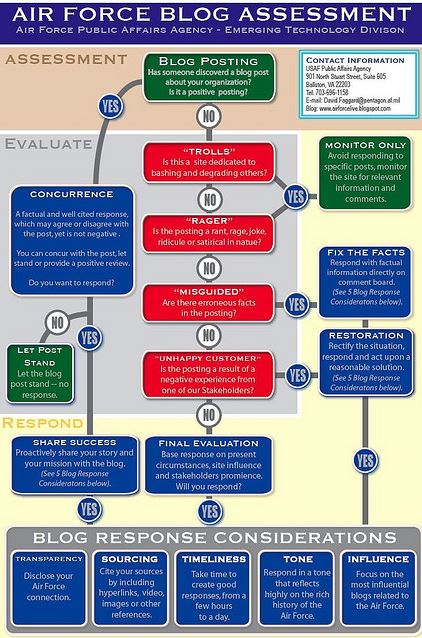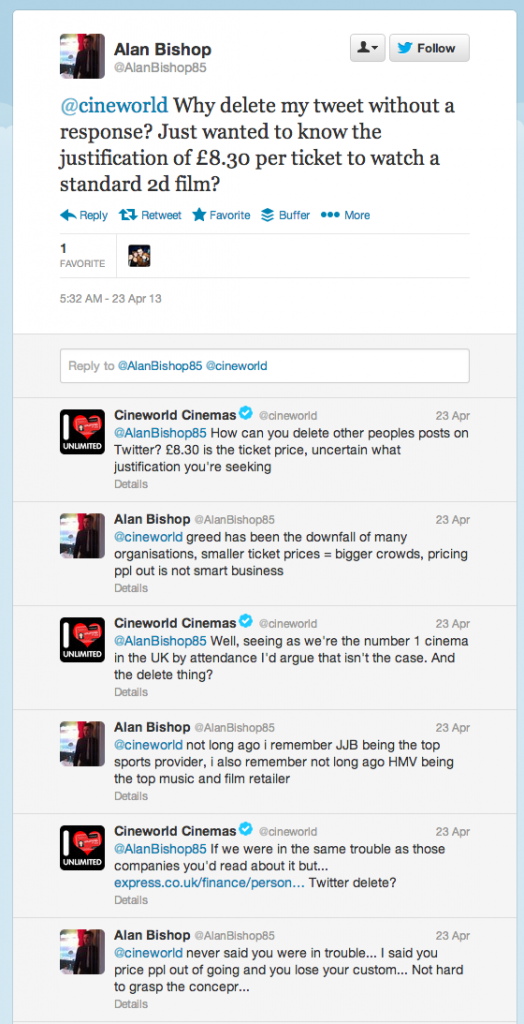My team and I have recently come across a little hurdle: our client was hesitant to utilize social media, despite the fact that many of his competitors had already dived in. Why? Fear for lack of control. His concern was: “If there are negative comments, what should we do?” The first step to this? Plan ahead with a social media response triage!
Definition:
Social Media Triage – a simple form of decision tree that allows us to take a systematic approach to how we go about assessing and responding to messages, posts, etc.
Example:
One social media triage I quite like is Air Force’s Blog Assessment flow chart:
The fact that ‘Trolls’ is used as a category is a good enough reason for me to like it, but I also like how the Air Force’s social media triage highlights 5 key considerations when conversing and responding: Transparency, Sourcing, Timeliness, Tone, and Influence.
Many companies underestimate the tone in a brand message and sometimes even tarnish brand reputation as a result. Take a look at this Cineworld Twitter spat example:
Read the full conversation here.
Even if the customer may not be completely correct, what they may not realize is that, people often judge an individual or brand on social media based on HOW they do something, sometimes even more than on WHAT they do. Publicly arguing with a customer is a big nono, regardless of whether it is on the social sphere or in real life. Tone and a consistent brand voice are incredibly vital factors on social media and should not be taken too lightly! One possible solution to misguided customers is to offer to take the discussion offline, e.g. offer a phone number where they can contact you, and comment online afterwards to say that the problem has been resolved. A company can customize a social media triage to include guidelines such as this according to their needs.
Looking to create a social media triage for your personal brand or company? Here are some useful tips on how you can make the social media triage work for you!
Key Takeaways:
1) Learning to participate in the social web – not just listening and monitoring, but responding as well – involves understanding that a level of freedom must be given to any staff member using social media.
If you don’t give them a level of freedom, it will become very tedious and take a long time before tweets, posts, or responses can be pushed out. But some restrictions or guidelines should still be put into place, for example, distribute a ‘Tone of Voice’ guideline to staff in charge of social media.
2) Social media triage goes hand in hand with a crisis communications plan, but doesn’t replace it.
While a triage system can be helpful for novice social media programs, make sure your communication process isn’t complicating problems. After all, social media is meant to make communications easier, not more tedious.
3) Sometimes it’s okay to step back and wait to see if your community steps in.
You don’t always have to respond to everything, even if someone says something bad about your brand, product or service, especially if they are a ‘Troll’ or a ‘Rager’ (see Air Force social media triage above). Sometimes, other consumers may realize that the poster is a ‘troll’ and simply disregard their comment, or sometimes, they may even defend your brand for you!
4) You can establish a time-frame for response.
This can ensure timeliness of your response.
5) A triage chart is a concrete way to show staff how your social media policy works.
Not all staff will know what to do when your brand first sets out into the social media universe. Having a social media triage will ensure better control over the consistency and quality of posts. This is especially useful for companies who have had little prior experience in social media.
6) Be mindful of Tone, as well as Transparency, Sourcing, Timeliness, and Influence when conversing online.
The tone of voice should always be professional and reflect a brand’s personality. Hence, be careful when outsourcing social media management.
7) When delegating tweets to outside agencies, contractors or even junior employees, assign them limited permissions.
The right social media management tool, such as HootSuite Teams, will let you designate which team members can draft and which can actually publish tweets. Drafts can be fed into an approval queue to be vetted by senior management before publishing, avoiding PR disasters. This may take a longer time, so you may want to skip this for routine tweets and only review ‘irregular’ tweets, for example, tweets in response to a customer complaint. It’s all about finding a balance, so companies may have to explore a bit before they find what’s best for them.
Relevant Links:
10 Reasons to Have a Social Media Response Triage Flowchart @ SocialFish
5 Tips for Creating More Efficient Social Media Processes @ Mashable
When Crisis Strikes: Four Do’s and Don’ts of Social Media Triage

